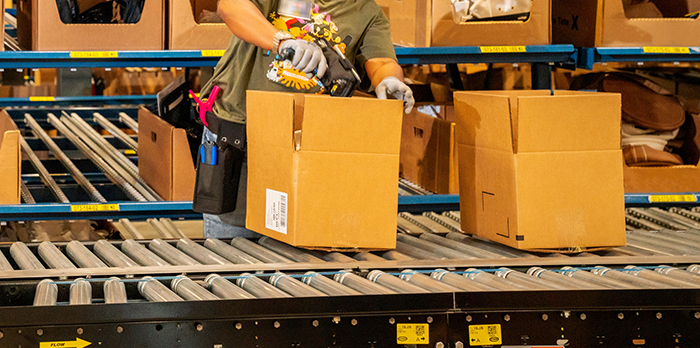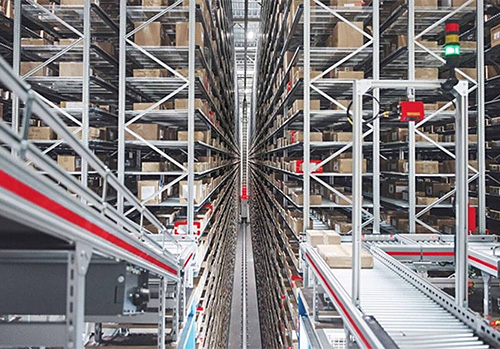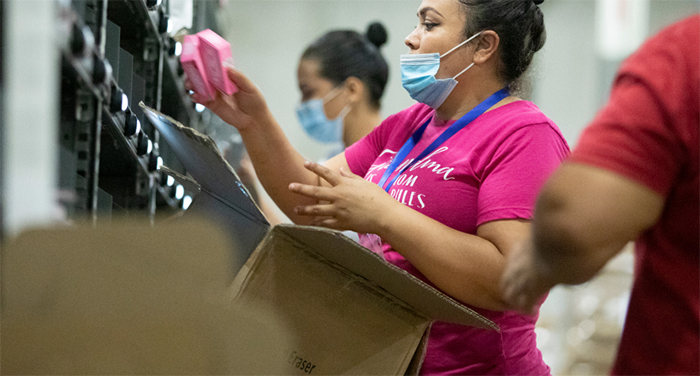Order Picking, Accuracy and ROI for Industrial Automation
How to justify automated material handling systems

You could write a short novel–maybe a long one–about ROI for industrial automation projects.
If you’ve engaged in large-scale distribution or manufacturing automation projects, you probably have a good start on that very thing. ROI is a complicated endeavor with moving parts and shifting priorities. Because investments are always competing with other concepts, it often comes down to this: what’s most important to your company, your business environment and your industry.
While the number of potential angles can help you justify any particular project, some of these can include:
- Increased Productivity: automation performs consistently at high speeds, boosting overall production efficiency.
- Labor cost reduction: This is often the most-discussed variable, and for good reason. Labor accounts for up to 65% of the cost of a warehouse operation – while we’re looking at a contracting labor pool that gets smaller each year.
- Quality, accuracy and consistency: Because they’re consistent and precise, you get predictable outcomes from automated systems. Almost every form of automation is highly accurate. You also experience fewer disruptions due to absences and other labor-related factors.
- Operational flexibility: While it’s true that automation can be rigid, it also provides flexibility. It can run 24-7. It can reduce the need for extra shifts and the people it takes to staff them. That type of flexibility is often underrated.
- Safer operations: Because you’re preventing an accident that may never happen, people struggle with automation and safety. The thing to remember is that if you reduce forklift traffic with a high-density AS/RS system, you instantly reduce the number of forklifts and the pedestrian traffic around them. If you remove people from harsh environments and replace them with robots, safety issues are dramatically improved.
- Scalability: Automation can be scaled with relative ease compared to manual methods. It’s easier to increase storage density than to expand; easier to add robots than people; easier to deliver more directly to pickers and processers than it is to move them to work positions.

Above: Mini-load AS/RS system in a distribution center
Accuracy and ROI: the factors
Because labor-related factors are so critical, it’s not wrong to focus on them. Any good ROI analysis must do that, but there are other factors that tie directly to labor, and picking accuracy is one of them. Accuracy is sometimes undervalued in ROI analysis and it should be factored in heavily. In most distribution operations, picking is the most common activity. It’s done every day, all day.
To say the least, an activity this common is worth your time to analyze when you’re looking at an automated system.
- Best-in-class companies achieve 99.9% accuracy, according to WERC (the Warehousing Education and Research Council).
- Average fulfillment operations fall in 97% or 98% accuracy range.
- You can be well above average and still realize significant ROI on accuracy improvements.
Is a 3% rate of inaccurate picks acceptable? The answer to that question has to be seen through the prism of the cascading costs associated with mis-picks. While it’s impossible to know what a missed pick costs your operation until you’ve analyzed it in depth, you can execute a strong “back of the napkin” guess.
Read more: Order Picking Error Rates: What’s Acceptable?
The costs of inaccurate picking
- Shipping it three times: You’ll ship the original, then pay for the return, then pay again for the outbound corrected shipment. This transaction alone could eat the profit from an order in one swoop.
- Damage-related costs: Every time you ship or handle something, the odds of damage increase.
- The returns process: If you’re receiving product back, then you’ll need a returns department, process and people. These costs soak into just about every aspect of a business from the warehouse to accounting to customer service.
- Repackaging costs: You probably need to provide packaging for the item’s return, then if it’s in good condition, you’ll need to re-package it.
- Labor requirements double or triple throughout the process: Labor is already too expensive, but moreso if you have to pick an item, then receive it back, then restock it, then ship the right one out again. The number of times you have to touch that item has tripled or quadrupled from a single mis-pick.
Lost customer faith should be your primary concern
Because customers have many choices and are loyal only to performance, picking accuracy’s greatest cost is that of lost customer faith. Your company’s reputation and lost repeat business should be the primary consideration.
How bad is it? 17% of American customers will leave a brand after only one poor experience, according to PWC. That goes up to 59% after several poor experiences. Depending on how you handle them, incorrect orders can be among the worst customer experiences. While late shipments, sting, wrong shipments are almost always more frustrating to customers.
Read more: Order Fulfillment is the First Line of a Great Customer Experience
The role of putaway

Above: put-to-light systems can improve order fulfillment operations by simplifying the process. Ideal for retail distribution and fulfillment.
People tend to focus on the point of picking, but the upstream processes can have profound impacts on order picking accuracy. If the putaway process isn’t rigorous, defined and logical, order pickers will need to sort out the mistakes that originated upstream. In general, accuracy improves when there are fewer variables: less “garbage in” means less “garbage out” in the system. If pickers need to sort through shifting locations and arbitrary placements, they will naturally be less effective at the pick station. When putaway is done right, it’s done with a purpose and in predictable ways.
You can automate both putaway and picking, but both processes require good procedures to thrive. Your process must be in place, updated and enforced.
Quality control and error rates
Many companies engage in quality control to catch errors before they ship, and this tends to reduce the costs of error. After all, if you catch it before it ships. you eliminate cross-shipments, customer frustration, and can send the order back into the system to be righted up. That’s orders of magnitude less expensive than shipping out that mistake. Some simple methods include:
- Automated weighing, which alerts you to variances in package weight vs. projected weight.
- Simple counts: do the number of items in the order match?
- Visual inspection, which strives to match each order to its pick ticket.
- Buffer loops in your conveyor system that hold questionable orders until they can be rectified.
- In-depth order matching, which usually involves a dedicated staff.
Ideally, you wouldn’t need to do any of this, but quality control is almost always worth the investment at scale and can generate ROI of its own by eliminating the worst aspects of picking mistakes.
Example: simple ROI for picking accuracy
Data point |
Projected metrics |
| Lines picked/year | 1,000,000 |
| Accuracy rate | 97% |
| Errors per year at accuracy rate | 30,000 |
| Average mis-pick cost | $50 per inaccurate pick (experts place the range at $75 to $300) |
| Annual cost of picking errors | $1.5 million |
This is a broad look at a fairly high volume operation, but is a useful way to visualize the impact of a single mis-pick.
Your company may be seeing greater or lesser impacts based on the value of products, the nature of the industry and the processes being utilized. Since customer service, returns processing, shipping, financial transactions, repackaging and lost product can weigh in, the cost of a bad pick tends to be greater than most companies estimate.
If you reduce that error rate from 3% to 2% at these simple numbers, you recoup $500,000 once your new automation, system or process is effective–and you do that every year moving forward.
Calculating the costs
To understand the cost of inaccuracy, you should start with the situation as you currently experience it. To do this, built a worksheet that provides these factors:
- Do you know the cost of a wrong pick, including all the variables? Can you quantify lost customers following a mis-pick?
- Have you identified the upstream and downstream factors from the point of pick?
- Is your process simple or complex? Provide pickers with a narrow scope of SKUs and clear instructions to reduce the error rate. The simpler the better.
- Do you rely on tribal knowledge and other methods that reduce accuracy?
- Do pickers deal with ergonomic factors that reduce accuracy? Those might include excessive walking, ergonomic reaching, climbing, stretching, and environmental issues such as lighting or climate?
- Does your inventory process support higher picking accuracy?
- Is the picking process simple? Can you train a new picker in a relatively short timeframe?
- What are the pickers saying about the process? Where does it fail them?
Inaccuracy is expensive
Avoid the return if at all possible, because aside from the cascading waterfall of costs, poor picking accuracy is probably the biggest avoidable threat to your business. The scale of problems that originate with a mis-pick is large and it reverberates throughout your entire operation. The ROI of processes, training and technology to reduce that mis-pick may be your best investment when it comes to bang for your buck.
Human error will always exist, so resist any ROI calculation that eliminates errors. That isn’t possible, but improvements are absolutely possible.
Tags: Automation, return on investment, order fulfilment
Scott Stone is Cisco-Eagle's Vice President of Marketing with 35 years of experience in material handling, warehousing and industrial operations. His work is published in multiple industry journals an websites on a variety of warehousing topics. He writes about automation, warehousing, safety, manufacturing and other areas of concern for industrial operations and those who operate them.



